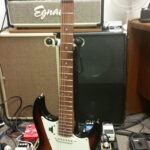Bass Guitar Amplifiers are specifically engineered audio amplification systems, distinct from those used for other instruments. This specialization arises from the unique challenges of reproducing low-frequency sounds effectively. These challenges influence the design of every component, from the loudspeakers and speaker cabinets to the preamp and amplifier sections themselves.
Speaker cabinets designed for bass guitar amps typically incorporate larger loudspeakers, or a greater number of them, compared to cabinets for instruments with higher frequency ranges. These loudspeakers are built to be more robust, capable of withstanding higher power levels required for bass frequencies. Construction is also a key difference; bass speaker cabinets are generally more rigidly built and feature heavier bracing to handle the powerful vibrations. To further enhance low-frequency efficiency, they often include tuned bass reflex ports or vents.
Due to the high power demands inherent in bass amplification, bass guitar amps are more frequently designed with cooling fans than standard guitar amplifiers. Another common feature is the inclusion of limiter circuitry. This crucial component prevents the power amplifier from being overloaded and safeguards the speakers from potential damage caused by excessive power output.
Tube Bass Amps: The Warmth of Vacuum Tubes
Until the early 1970s, vacuum tubes were the primary active electronic components in bass amplifiers. Even today, tubes remain highly sought after and are used in many high-end bass guitar amp models. Many bass players favor tube amplifiers for what they perceive as a “warmer” and more “natural” sound, especially when the amp is driven lightly or moderately. When pushed harder, tube amps are known for producing pleasing distortion characteristics that many musicians find desirable. Furthermore, some players believe that tube amps offer a greater perceived loudness compared to solid-state amps, even with the same power rating.
Solid-State Bass Amps: Reliability and Efficiency
The 1960s and 1970s saw the rise in popularity of semiconductor transistor-based amplifiers, known as solid-state amps. This shift was largely driven by the advantages of solid-state technology: lower cost, lighter weight, and reduced maintenance compared to their tube counterparts. In modern bass guitar amp design, hybrid approaches are also common. These designs often combine a tube preamp stage with a solid-state power amplifier, seeking to blend the tonal characteristics of tubes with the efficiency of solid-state technology. Additionally, the market now offers a growing selection of bass guitar amps utilizing digital signal processing and digital modeling. These advanced amps digitally simulate a wide array of classic amp and cabinet combinations, providing versatility and a broad palette of tones for bass players.

